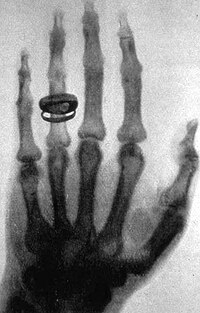
Photo from wikipedia
Diagnostic procedures are mostly used to detect a particular disease, and each procedure indicates the presence or absence of the disease in an individual. Sensitivity and positive predictive value, which… Click to show full abstract
Diagnostic procedures are mostly used to detect a particular disease, and each procedure indicates the presence or absence of the disease in an individual. Sensitivity and positive predictive value, which are measures of the effectiveness of a diagnostic procedure, are simply calculated as the proportion of the individuals diagnosed with the disease by the test among the patients with the disease, and of the diseased persons among the individuals in whom the disease was detected by the test, respectively. For a diagnosis with such a binary result, sensitivity and the positive predictive value of diagnostic procedures can be compared using the chi-square statistic. However, in the treatment of cancer patients, it is important not only to diagnose the disease status of an individual patient but also to detect the correct location of the cancer. The tumor location may be incorrectly identified in some subjects diagnosed with cancer. It is therefore of interest whether a procedure that diagnoses cancer also correctly indicates the tumor location. In this paper, we re-define the sensitivity and the positive predictive value of tumor detection as the ratio of the number of cases with a correct diagnosis of the tumor location by the test to the number of cases of cancer, and as the ratio of patients with a correct diagnosis of the tumor location to the number of individuals diagnosed with cancer by the test, respectively. We refer to these parameters as ‘semi-sensitivity’ and ‘semi-positive predictive value’. To compare these ratios between diagnostic procedures, test statistics are developed from binary diagnostic results. Simulation studies conducted to evaluate the nominal level and power are presented, and two sets of example data are also analyzed using the new test statistic.
Journal Title: Statistical Methods in Medical Research
Year Published: 2019
Link to full text (if available)
Share on Social Media: Sign Up to like & get
recommendations!